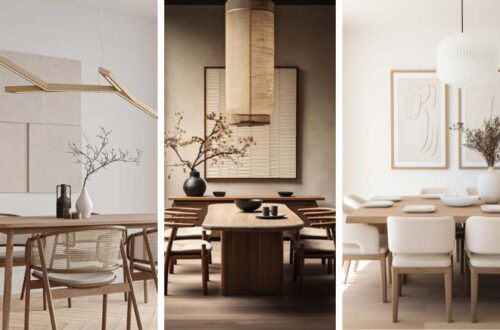
Japandi Color Palette
Share this
In this article, we’ll explore the best Japandi color palette, from neutrals tones to accent colors, and everything in between.
You’ll also find some practical tips on selecting the best hues for different types of rooms, with examples ranging from finishes to furniture and decorative accessories.
Japandi Color Palette
What is Japandi?
You might be wondering, what exactly is Japandi?
Simply put, Japandi is not just an interior design style; it’s a philosophy that permeates the space.
On one side, we have the Japanese style, which is rooted in the Wabi Sabi philosophy—embracing imperfection and transience.
On the other side, we have Scandinavian design, renowned for its minimalism and functionality.
Combine JAPANese and scanDI, and you get Japandi—a harmonious blend of these two aesthetics.
This fusion creates a balanced and beautiful space.
Although Japan and Nordic countries are geographically distant, they share similar ideologies, such as the appreciation for simplicity in design and a deep respect for nature.
In Japandi style, the Japanese appreciation for the beauty in imperfection known as Wabi-Sabi blends seamlessly with Scandinavian minimalism.
The Japandi color palette is both relaxing and inviting.
This makes it an ideal choice for everyone—whether you have a highly developed sense of style or limited knowledge but still want to ensure you don’t waste money on colors you might dislike once they’re on your walls.
In this blog, I’ll also be sharing Japandi color palettes inspired by photographs of interiors that showcase this unique style.
Don’t forget to Pin!
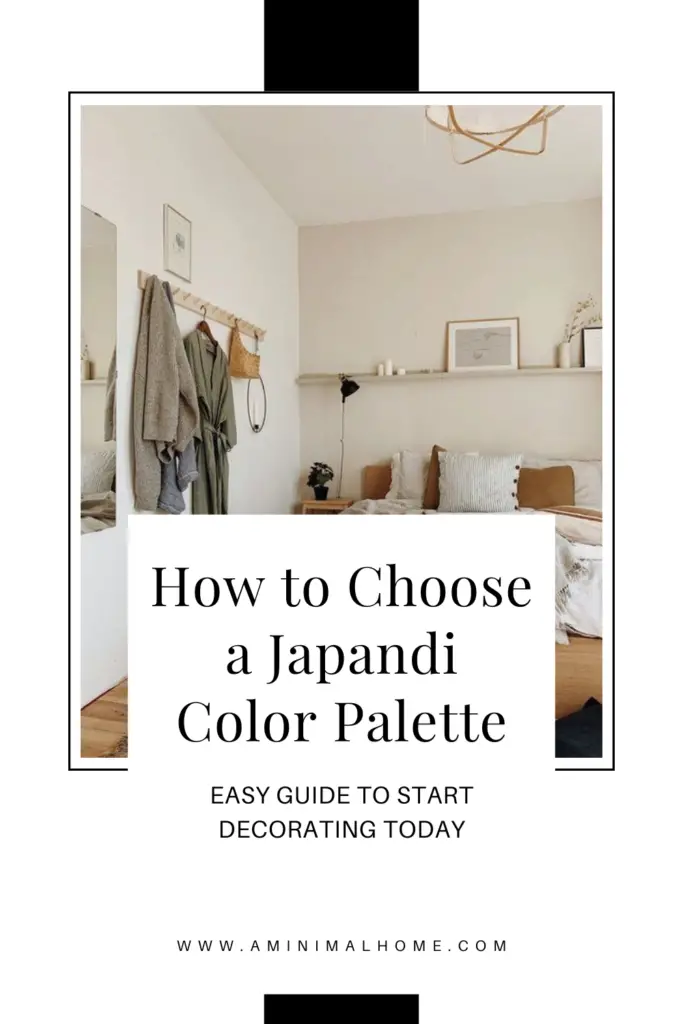
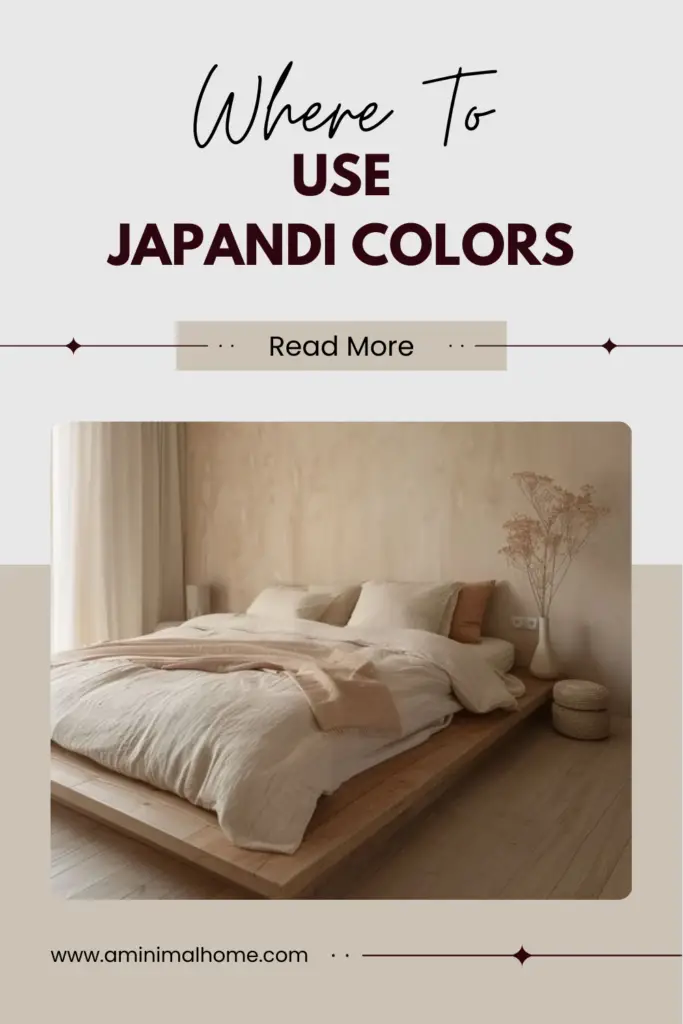
Understanding the Japandi Aesthetic
Japandi is a hybrid style emphasizes simplicity, natural elements, and balance, making it an ideal choice for those who seek a serene and clutter-free environment.
Let’s explore the core principles that define Japandi design and how they can transform your living space.
Simplicity
At the heart of Japandi design lies simplicity.
This principle is about stripping away the unnecessary and focusing on what’s truly essential.
- Minimalist Aesthetic: Adopt a “less is more” philosophy by choosing furniture and decor pieces that serve a purpose and bring joy. Avoid over-decorating your space with items that don’t add value.
- Clean Lines and Forms: Opt for furniture with clean lines and simple forms. This creates a sense of order and calm, essential for a soothing environment.
- Neutral Color Palette: Use a neutral color palette and muted tones. These colors create a peaceful backdrop that allows natural elements to shine.
Natural Elements
Integrating natural materials is crucial in Japandi design, as it helps to create a connection with nature and adds warmth to the space.
- Organic Materials: Choose materials like wood, stone, and bamboo. These elements bring a touch of nature indoors and add texture and depth to your design.
- Indoor Plants: Incorporate indoor plants to introduce greenery and life into your space. Plants like bonsai, snake plants, and ferns are perfect for Japandi interiors due to their low maintenance and aesthetic appeal.
- Natural Light: Maximize natural light by using sheer curtains or blinds that can be easily drawn back. Natural light enhances the ambiance and highlights the beauty of your minimalist decor.
Balance
Achieving balance is essential in Japandi style, as it harmonizes the contrasting elements of Japanese and Scandinavian styles.
- Symmetry and Proportion: Ensure that your furniture and decor are arranged in a way that promotes symmetry and proportion. This creates a sense of equilibrium and visual harmony.
- Functional Spaces: Designate areas for specific activities and ensure that each space serves its intended function effectively. This not only enhances practicality but also contributes to a balanced living environment.
- Contrasting Textures: Mix and match different textures to add interest and depth. For example, pair a smooth wooden table with a soft woolen rug or a sleek metal lamp with a woven basket.
Japandi Color Palette
One of the most significant differences between Japanese and Scandinavian design styles lies in their color palettes.
Traditional Japanese Style
- Color Palette: Traditional Japanese design focuses on darker tones, such as black, terracotta, and various shades of brown which add depth.
- These colors create a warm and grounded atmosphere, reflecting the natural elements often emphasized in Japanese culture.
Scandinavian Style
- Color Palette: In contrast, Scandinavian design favors muted color like white and beige. This palette contributes to a clean, minimalistic look and often evokes a cooler ambiance, emphasizing simplicity and functionality.
The Emergence of Japandi
The Japandi asthetic, a hybrid design style, takes the best elements from both Japanese and Scandinavian aesthetics to create a balanced and harmonious color palette.
- Balanced Neutrals: Japandi combines the neutral tones of Scandinavian design with the warm, earthy hues of Japanese design. This fusion results in a harmonious blend that is both calming and inviting, offering the perfect balance of warmth and minimalism.
By merging these two distinct styles, Japandi offers a unique and cohesive design approach that leverages the strengths of both Japanese and Scandinavian traditions.
Now, let’s see the choice for a Japandi color palette.
Neutral Base Colors
The foundation of Japandi color palette is built on neutral colors.
These tones create a sense of calm and balanced atmosphere, creating a perfect blend of Scandinavian minimalism and Japanese elegance.
Think whites, beiges, and soft grays—these hues create a serene backdrop that allows other elements to shine.
White
White is not just a color; it’s a philosophy. In Japandi design, white serves multiple purposes:
- Purity and Simplicity: White embodies the minimalist ethos of both Japanese and Scandinavian design, creating a sense of purity and simplicity.
- Light and Space: It reflects light, making rooms feel more spacious and airy.
- Versatility: White provides a neutral canvas that allows other design elements to stand out.
Beige
One of the strengths of beige is its versatility.
It serves as a versatile backdrop that complements other elements in Japandi design, such as wooden textures, green plants, and minimalist furniture.
This neutral color allows these elements to shine without overpowering them.
Gray
Gray comes in various shades, from light dove gray to deep charcoal.
This range allows you to play with different tones to create depth and interest in your decor.
Whether you’re using gray as a wall color, in furniture, or as an accent, it complements other colors and materials effortlessly.
Earthy Tones
While neutrals form the base, accessory colors add depth and interest.
Consider incorporating muted pastels or earthy greens and blues.
These colors complement the neutral palette without overwhelming the space, maintaining the understated elegance of Japandi style.
Muted Greens
Muted greens, such as sage, olive, and eucalyptus, are perfect for creating a serene and comfortable environment.
These shades are subtle yet impactful, providing a calming backdrop that aligns perfectly with Japandi’s principles of simplicity and natural beauty.
Soft Browns
Incorporating shades of brown can add depth and richness to your Japanese-inspired decor.
The warm, earthy tones truly capture the Japanese essence in decor.
Whether you opt for walnut furniture, bamboo accents, or soft brown textiles, this versatile color can enhance the serenity and sophistication of your home.
Terracotta
Terracotta, with its warm, earthy tones and natural texture, is the perfect element to introduce a rustic vibe into your Japandi-inspired space.
The rich hues of terracotta can add depth and warmth, making your home feel more inviting and cozy without disrupting the minimalist essence of Japandi design.
Accent Colors
An accent color is where you can inject a bit of personality and vibrancy into your Japandi décor.
Opt for rich, natural shades like deep greens, terracotta, or even a bold charcoal.
These accents should be used sparingly to highlight specific areas or features in the room, ensuring they stand out against the more subdued background.
- Deep Blues – Adding a touch of tranquility.
- Charcoal and Black – Creating contrast and grounding the space.
- Warm Metallics (Gold, Brass) – Adding a hint of luxury.
Where and How to Use Japandi Colors

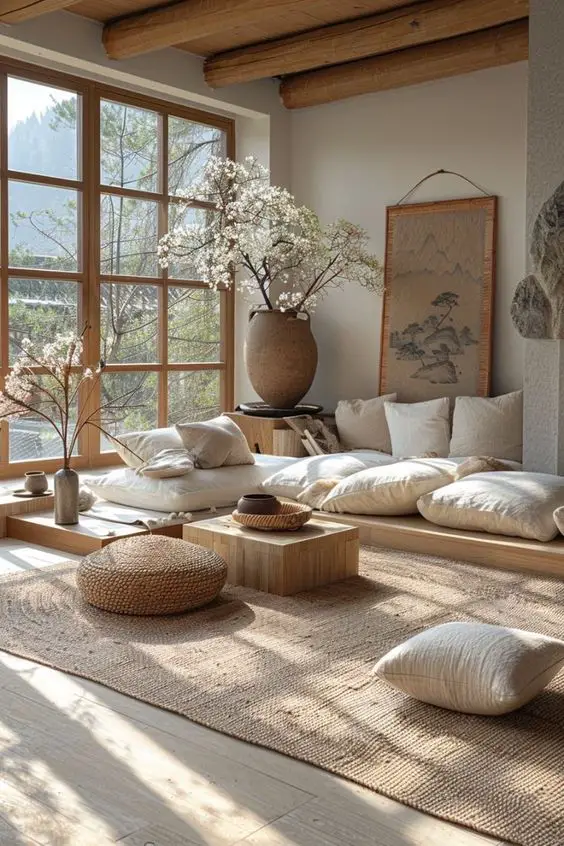
Living Room
For a Japandi living room, stick to soft neutrals on walls and larger furniture pieces. Add interest with textured accessories in muted greens or blues.
Start with the Walls
Paint your walls in a neutral shade.
This sets the stage for your earthy accents and ensures they stand out. White, cream, or a light gray are excellent choices.
Choose Key Furniture Pieces
Select key furniture pieces like sofas and chairs in neutral colors.
This provides a versatile foundation that can be easily accented with earthy tones.
Incorporate Textiles
Use rugs, throw pillows, and curtains in earthy tones.
These elements are easy to switch out if you want a new look down the line.
Consider textiles in shades like rust, mustard, or forest green.
Add Natural Elements
Incorporate natural materials like wood, stone, and plants.
A wooden coffee table or a few potted plants can enhance the earthy vibe while complementing your neutral base.
Play with Patterns
Mix in patterns that feature earthy tones.
Geometric or tribal designs can add an extra layer of visual interest without overwhelming the space.
Accessorize Thoughtfully
Use accessories like vases, artwork, and decorative objects in earthy tones.
These small touches can make a big impact and are easy to update as trends change.
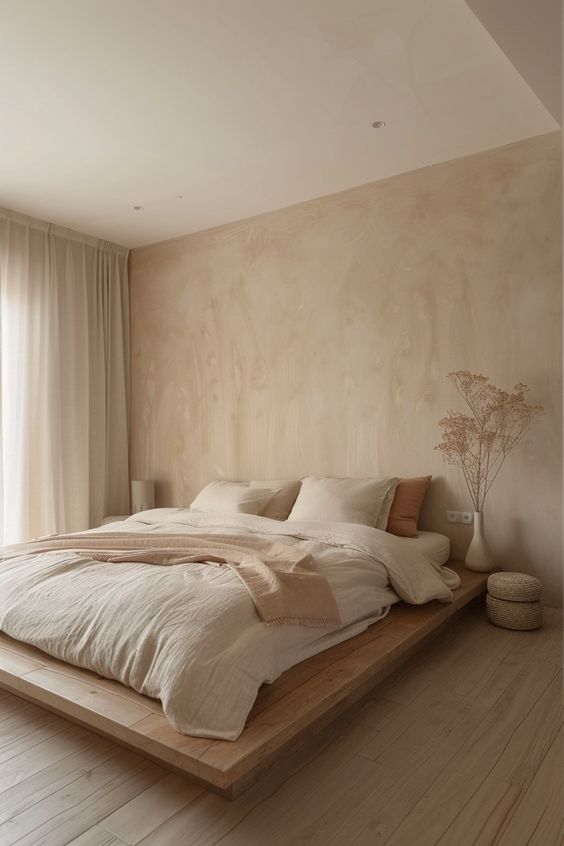

Bedroom
In the bedroom, create a calming atmosphere with tones like beige and light gray work best for a restful atmosphere.
Introduce accent colors through bedding or artwork to create a cozy yet stylish space.
Related: Japandi Bedroom


Kitchen
Neutral cabinets and countertops set the stage in a Japandi kitchen interior design.
Use accent colors in small appliances or dishware to add subtle pops without disrupting the minimalist vibe.
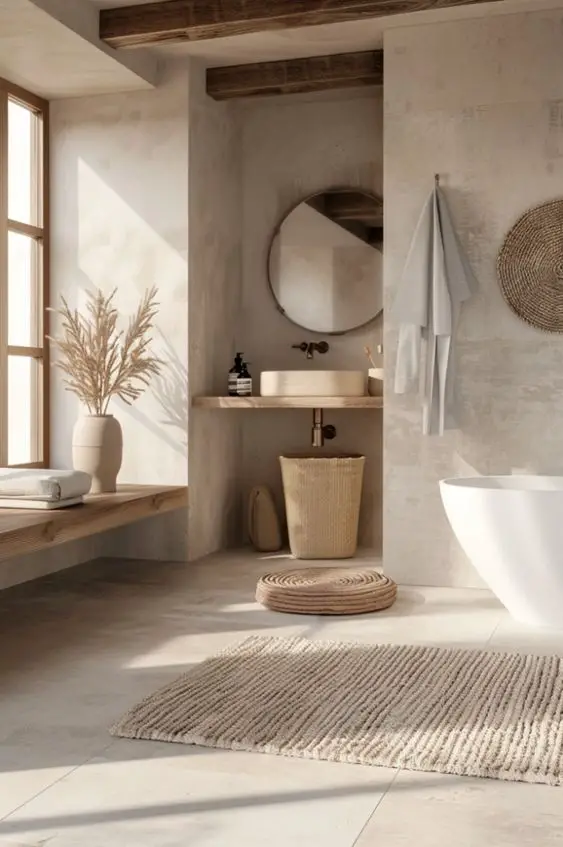

Bathroom
A Japandi bathroom thrives on simplicity.
Light, neutral tiles paired with wooden accents create a spa-like retreat. Add small plants or towels in earthy tones for an extra touch of nature.
Related: Japandi Bathroom
How To Choose A Color Palette For Your Home
Step 1: Assess Your Existing Space
Before introducing new colors, it’s essential to understand the current state of your home.
Here’s what to consider:
Evaluate Current Colors
- Wall Colors: Note the color scheme of your walls and any patterns or textures.
- Furniture: Look at the dominant colors in your furniture pieces.
- Decorative Elements: Pay attention to rugs, curtains, and other accessories that add splashes of color.
Identify Fixed Elements
- Flooring: The color and material of your floors can dictate your color choices.
- Cabinetry: Especially in kitchens and bathrooms, the existing cabinetry color is a significant factor.
- Architectural Features: Elements like exposed beams, brick walls, or tiles should also be considered.
Step 2: Assess Lighting
Artificial Light: Note the type and color temperature of artificial lighting used in each room.
Natural Light: Understand how natural light affects your space throughout the day.
Step 3: Choose Your Color Palette
Now that you’ve assessed your space and identified areas for improvement, it’s time to choose your color palette.
Start with a Base Color
- Neutral Tones: A base color in a neutral tone can serve as a foundation for your palette.
- Consistency: Ensure the base color works well with fixed elements like flooring and cabinetry.
Add Complementary Colors
- Contrast: Choose colors that contrast well with your base color for visual interest.
- Harmony: Ensure the complementary colors harmonize with each other and the overall theme of your home.
Incorporate Accent Colors
- Pops of Color: Use bold and vibrant hues sparingly to add character and liveliness.
- Seasonal Variations: Consider how you might switch up accent colors with the seasons for a fresh look.
Step 4: Incorporate Wood and Plants
Choose Quality Wooden Furniture
Select quality wooden furniture with clean lines and a minimalist aesthetic.
Think of oak or teak pieces that embody both Japanese simplicity and Scandinavian functionality.
A solid wood dining table or a sleek wooden shelving unit can serve as focal points in your decor.
Integrate Wooden Accents
Incorporate wooden accents like picture frames, bowls, or wall panels.
These small touches can significantly enhance the natural feel of your space without overwhelming it.
Add Greenery
The essence of the Japandi design also introduces a variety of plants to your rooms.
Consider easy-to-care-for options like snake plants, fiddle leaf figs, or succulents.
Place them in simple, understated pots that complement the overall decor theme.
Create a Balanced Layout
Balance is crucial in Japandi decor.
Arrange your wooden furniture and plants in a way that promotes harmony and uncluttered spaces.
Avoid overcrowding any area and make sure each piece has room to breathe.
Step 5: Test Before You Commit
Before committing to the Japandi design trends, it’s wise to test the colors in your space.
Paint Samples
- Sample Swatches: Apply paint samples to different walls and observe how they look at various times of the day.
- Temporary Decor: Use temporary decor items like cushions or throws in your chosen colors to see how they fit.
Seek Opinions
- Get Feedback: Ask friends or family for their opinions on your color choices.
- Professional Advice: Consider consulting with an interior designer for expert advice.
Don’t forget to Pin!
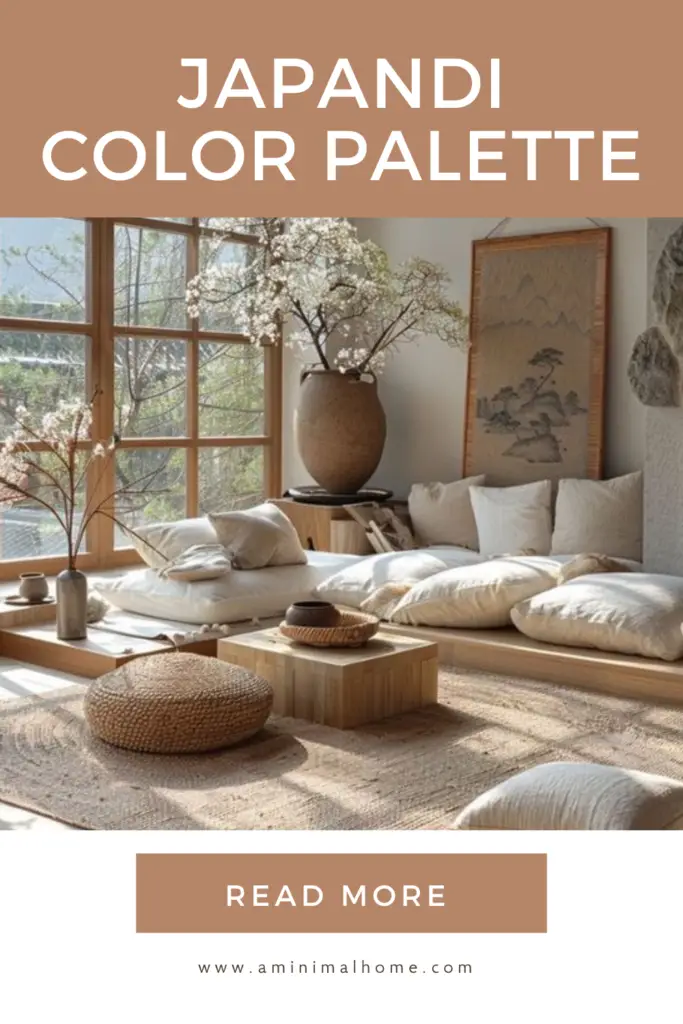

Conclusion
By following these guidelines, you can achieve a harmonious Japandi style that’s both functional and aesthetically pleasing.
Experiment with different combinations to find what best suits your space and personal taste.
Take the first step towards mastering the simplicty nature of the Japandi color palette by implementing these practical tips in your home.
Love what you see?
Don’t miss out on the latest trends, tips, and inspiration in interior design!
Book mark my website and subscribe to my newsletter to get fresh ideas and expert advice delivered straight to your inbox.
Join my community of design enthusiasts and transform your space.



